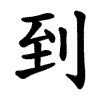到
- to arrive, to reach, to attain;
Etymology
Phono-semantic compound:
至 (이를 지) — semantic element, meaning “to reach” or “to arrive.”
刀 (칼 도) — phonetic element, providing the sound do and nuance of sharpness or precision.
Originally, 到 depicted the act of arriving exactly at a point or boundary — the sense of “reaching the mark.”
The combination of 至 (arrival) with 刀 (cutting edge) visually and conceptually represents a movement that comes sharply to its destination.
In oracle and bronze inscriptions, the forms of 到 are not attested, as it is a later derived compound from 至 and 刀 that appeared in small seal script (小篆).
By the clerical script (隸書) period, it took the standardized modern form with the semantic top (至) and the phonetic bottom (刀).
Usage in Korean
도착(到着) — arrival, reaching a place.
도달(到達) — to reach a point or achieve something.
도래(到來) — coming, advent (often figurative: “the coming of an era”).
도성(到成) — completion, accomplishment.
미도(未到) — not yet reached.
The character 到 functions both literally (movement in space) and metaphorically (achievement, fulfillment, arrival of time or event).
It appears in classical, literary, and modern Sino-Korean vocabulary alike.
Words that derived from 到
Additional notes
In early Chinese, 到 denoted physical arrival — “to come to a place” — but soon extended to temporal arrival (“when the time comes”) and mental attainment (“to reach understanding”).
In classical texts:
「至而不至曰不到。」
“To go yet not arrive is called ‘not reaching’.” — Han Feizi (韓非子)
Later, its usage expanded to idiomatic and grammatical roles, such as a complement of result in modern Chinese grammar (e.g. 做到 “to manage to do,” 看不到 “cannot see”).
Cultural & philosophical notes:
到 carries profound symbolic resonance in classical Chinese thought — representing the moment of fulfillment or realization.
In Daoist and Confucian literature, “reaching” (到) often connotes achieving harmony or completion of a journey, whether physical, moral, or spiritual.
「學而不思則罔,思而不學則殆。學至於誠,則道自到。」
“Study without thought is futile; thought without study is perilous. When study reaches sincerity, the Way itself arrives (道自到).” — paraphrased from Analects (論語)
Thus, 到 embodies both arrival and attainment — the moment where action meets realization.
Symbolic interpretation:
到 symbolizes completion through arrival — the endpoint of movement, learning, or intention.
Its upper radical 至 represents the destination, while the lower 刀 marks the decisive moment of contact — as if one’s journey cuts sharply into its goal.
In spiritual or poetic imagery, 到 suggests the meeting of effort and destiny, the fulfillment of the path one has followed.
「行至水窮處,坐看雲起時。」
“When one walks to where the water ends, sit and watch the clouds rise.” — Wang Wei (王維)
The essence of 到 is arrival with awareness — not merely reaching a place, but realizing its meaning.
- 一土中弓 (MGLN)
- ⿰ 至 刂
